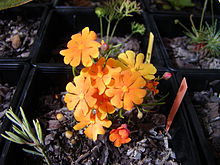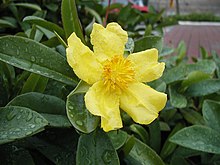Hibbertia: Difference between revisions
HAHHAHA GAYYY |
ClueBot NG (talk | contribs) m Reverting possible vandalism by 101.164.73.76 to version by Plantdrew. False positive? Report it. Thanks, ClueBot NG. (1597535) (Bot) |
||
| Line 13: | Line 13: | ||
|genus_authority=Andrews<ref name=APNI>{{cite web |url=http://www.anbg.gov.au/cgi-bin/apni?TAXON_NAME=Hibbertia|title=''Hibbertia'' |accessdate=18 March 2011 |work= [[Australian Plant Name Index]] (APNI), IBIS database|publisher = Centre for Plant Biodiversity Research, Australian Government, Canberra}}</ref> |
|genus_authority=Andrews<ref name=APNI>{{cite web |url=http://www.anbg.gov.au/cgi-bin/apni?TAXON_NAME=Hibbertia|title=''Hibbertia'' |accessdate=18 March 2011 |work= [[Australian Plant Name Index]] (APNI), IBIS database|publisher = Centre for Plant Biodiversity Research, Australian Government, Canberra}}</ref> |
||
|subdivision_ranks = [[Species]] |
|subdivision_ranks = [[Species]] |
||
|subdivision = See [[List of Hibbertia species|List of ''Hibbertia'' species]] |
|subdivision = See [[List of Hibbertia species|List of ''Hibbertia'' species]] |
||
|}} |
|}} |
||
'''''Hibbertia''''', or '''Guinea flower''', is a genus of trees, shrubs, trailing shrubs and climbers of the family [[Dilleniaceae]].<ref name=NSW>{{cite web |url=http://plantnet.rbgsyd.nsw.gov.au/cgi-bin/NSWfl.pl?page=nswfl&lvl=gn&name=Hibbertia |title=''Hibbertia''|accessdate=18 March 2011 |author=|work= PlantNET - New South Wales Flora Online |publisher=Royal Botanic Gardens & Domain Trust, Sydney Australia}}</ref><ref name=endemia/> The five-petalled flowers of all species are varying shades of yellow, with the exception of ''[[Hibbertia stellaris|H. stellaris]]'', ''[[Hibbertia miniata|H. miniata]]'' and ''[[Hibbertia selkii|H. selkii]]'', a recently named (1980s) species from the [[Stirling Ranges]], which all have orange flowers. Around 150 species occur in [[Australia]] of which two are also found in [[New Guinea]]. Additionally, 24 species occur in [[New Caledonia]], one of which is also found in [[Fiji]], and one other species is endemic to [[Madagascar]].<ref name=endemia>{{cite web|title=''Hibbertia'' (Genre) |
'''''Hibbertia''''', or '''Guinea flower''', is a genus of trees, shrubs, trailing shrubs and climbers of the family [[Dilleniaceae]].<ref name=NSW>{{cite web |url=http://plantnet.rbgsyd.nsw.gov.au/cgi-bin/NSWfl.pl?page=nswfl&lvl=gn&name=Hibbertia |title=''Hibbertia''|accessdate=18 March 2011 |author=|work= PlantNET - New South Wales Flora Online |publisher=Royal Botanic Gardens & Domain Trust, Sydney Australia}}</ref><ref name=endemia/> The five-petalled flowers of all species are varying shades of yellow, with the exception of ''[[Hibbertia stellaris|H. stellaris]]'', ''[[Hibbertia miniata|H. miniata]]'' and ''[[Hibbertia selkii|H. selkii]]'', a recently named (1980s) species from the [[Stirling Ranges]], which all have orange flowers. Around 150 species occur in [[Australia]] of which two are also found in [[New Guinea]]. Additionally, 24 species occur in [[New Caledonia]], one of which is also found in [[Fiji]], and one other species is endemic to [[Madagascar]].<ref name=endemia>{{cite web|title=''Hibbertia'' (Genre) |
||
| url=http://www.endemia.nc/flore/fiche318.html |work=endemia.nc - Faune & Flore de Nouvelle-Calédonie| accessdate=22 March 2011}}</ref> |
| url=http://www.endemia.nc/flore/fiche318.html |work=endemia.nc - Faune & Flore de Nouvelle-Calédonie| accessdate=22 March 2011}}</ref> |
||
The genus is currently being revised by Helmut Toelken of the South Australian Herbarium. |
The genus is currently being revised by Helmut Toelken of the South Australian Herbarium. |
||
The genus takes its name from [[George Hibbert]] (1757 - 1837), an eminent [[England|English]] merchant and amateur [[botanist]].<ref name=Corrick>{{cite book|author=Corrick, M.G. and Fuhrer, B.A.| title=Wildflowers of Victoria and adjoining areas| publisher=Bloomings Books|location= Australia | year=2001 | id=ISBN 1876473142}}</ref> |
The genus takes its name from [[George Hibbert]] (1757 - 1837), an eminent [[England|English]] merchant and amateur [[botanist]].<ref name=Corrick>{{cite book|author=Corrick, M.G. and Fuhrer, B.A.| title=Wildflowers of Victoria and adjoining areas| publisher=Bloomings Books|location= Australia | year=2001 | id=ISBN 1876473142}}</ref> |
||
Revision as of 07:30, 20 November 2013
| Hibbertia | |
|---|---|

| |
| Hibbertia stellaris | |
| Scientific classification | |
| Kingdom: | |
| (unranked): | |
| (unranked): | |
| (unranked): | |
| Order: | unplaced
|
| Family: | |
| Genus: | Hibbertia Andrews[1]
|
| Species | |
Hibbertia, or Guinea flower, is a genus of trees, shrubs, trailing shrubs and climbers of the family Dilleniaceae.[2][3] The five-petalled flowers of all species are varying shades of yellow, with the exception of H. stellaris, H. miniata and H. selkii, a recently named (1980s) species from the Stirling Ranges, which all have orange flowers. Around 150 species occur in Australia of which two are also found in New Guinea. Additionally, 24 species occur in New Caledonia, one of which is also found in Fiji, and one other species is endemic to Madagascar.[3] The genus is currently being revised by Helmut Toelken of the South Australian Herbarium.
The genus takes its name from George Hibbert (1757 - 1837), an eminent English merchant and amateur botanist.[4]
Identification
Given the similarity in flower colour and shape (In nearly all species, the five petals are obovate), the number of stamens is a useful method of identification as this can vary widely from 4 to about 200 depending on species.
Species


Species include:[1]
- Hibbertia amplexicaulis
- Hibbertia aspera - Rough Guinea-flower
- Hibbertia banksii
- Hibbertia basaltica
- Hibbertia bracteata
- Hibbertia cistiflora - Rock Rose Guinea-flower
- Hibbertia cuneiformis - Cut-leaf Hibbertia
- Hibbertia dentata - Twining Guinea-flower
- Hibbertia diffusa
- Hibbertia empetrifolia - Tangled Guinea-flower
- Hibbertia fasciculata
- Hibbertia furfuracea
- Hibbertia grossulariifolia - Gooseberry-leaved Guinea-flower
- Hibbertia hirta
- Hibbertia hypericoides - Yellow Buttercups
- Hibbertia incana - Prickly Guinea-flower
- Hibbertia linearis
- Hibbertia longifolia
- Hibbertia miniata - Orange Guinea-flower
- Hibbertia obtusifolia - Hoary Guinea-flower
- Hibbertia pedunculata - Stalked Guinea-flower
- Hibbertia procumbens
- Hibbertia prostrata - Bundled Guinea-flower
- Hibbertia riparia - Erect Guinea-flower
- Hibbertia scandens – Climbing Guinea-flower or Snake Vine
- Hibbertia selkii
- Hibbertia serrata
- Hibbertia sericea - Silky Guinea-flower
- Hibbertia serpyllifolia
- Hibbertia stellaris – Star Guinea-flower
- Hibbertia truncata - Port Campbell Guinea-flower
- Hibbertia vestita - Hairy Guinea-flower
References
- ^ a b "Hibbertia". Australian Plant Name Index (APNI), IBIS database. Centre for Plant Biodiversity Research, Australian Government, Canberra. Retrieved 18 March 2011.
- ^ "Hibbertia". PlantNET - New South Wales Flora Online. Royal Botanic Gardens & Domain Trust, Sydney Australia. Retrieved 18 March 2011.
- ^ a b "Hibbertia (Genre)". endemia.nc - Faune & Flore de Nouvelle-Calédonie. Retrieved 22 March 2011.
- ^ Corrick, M.G. and Fuhrer, B.A. (2001). Wildflowers of Victoria and adjoining areas. Australia: Bloomings Books. ISBN 1876473142.
{{cite book}}: CS1 maint: multiple names: authors list (link)
